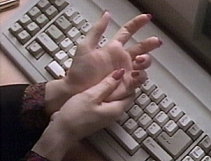CARPAL TUNNEL SYNDROME PREVENTION
How Can Carpal Tunnel Syndrome (CTS) Be Prevented?
Well-Connected Companies are now taking action to help prevent repetitive stress injuries. In a major survey, 84% reported that they were modifying equipment, tasks, and process; 83% were analyzing their workstations and jobs, and 79% were buying new equipment. No single mode of prevention exists for carpal tunnel syndrome. It is important, however, to use common sense and ergonomic controls to help minimize risk factors predisposing to work-related CTS or other cumulative trauma disorders. A patient can learn how to adjust the work area, handle tools, or perform tasks in ways that put less stress on the hands and wrists. Exercise programs to strengthen the fingers, hands, wrists, forearms, shoulders, and neck may help prevent CTS. It should be stressed, however, that there has been no evidence that any of these methods can provide complete protection against carpal tunnel syndrome. If the underlying cause is a medical condition, controlling the problem can prevent CTS.
Ergonomic Controls
Repetition and Rest

Posture
Force
The force placed on the fingers, hands, and wrists by a repetitive task contributes importantly to CTS. To alleviate the effect of force on the wrist, tools and tasks should be designed so that the wrist position is the same as it would be if the arms dangled in a relaxed manner at the sides. No task should require the wrist to deviate from side to side or to remain flexed or highly extended for long periods.
Keyboard operators should adjust the tension of the keys so that depressing the keyboard does not cause fatigue. The hands and wrists should remain in a relaxed position to avoid excessive force on the keyboard. For computer users, replacing the mouse with a trackball device and the standard keyboard with a jointed-type are helpful substitutions. Wrist rests, which fit under most keyboards, can help keep the wrists and fingers in a comfortable position.
The handles of such tools as screwdrivers, scrapers, paintbrushes, and buffers should be designed so that the force of the worker’s grip is distributed across the muscle between the base of the thumb and the little finger — not just in the center of the palm. People who need to hold any objects — such as a pencil, steering wheel, or tools — for long periods of time should grip them as loosely as possible. In order to apply force appropriately, the ability to feel an object is extremely important. Tools with textured handles are helpful. Working at low temperatures, which reduces sensation in hands and fingers, should be avoided if possible.
Vibration
Exercise
Wrists
Fingers and Hand
Forearms
Neck and Shoulders
General Exercise
Contact Us
13710 Olive Boulevard (Primary Office)
Chesterfield, MO 63017
Telephone: 314-469-PAIN (7246)
Fax: 314-469-7251
Exchange: 314-441-6965 (for after-hour Emergencies Only)
Hours:
Monday thru Friday
8:30 AM – 4:30 PM

